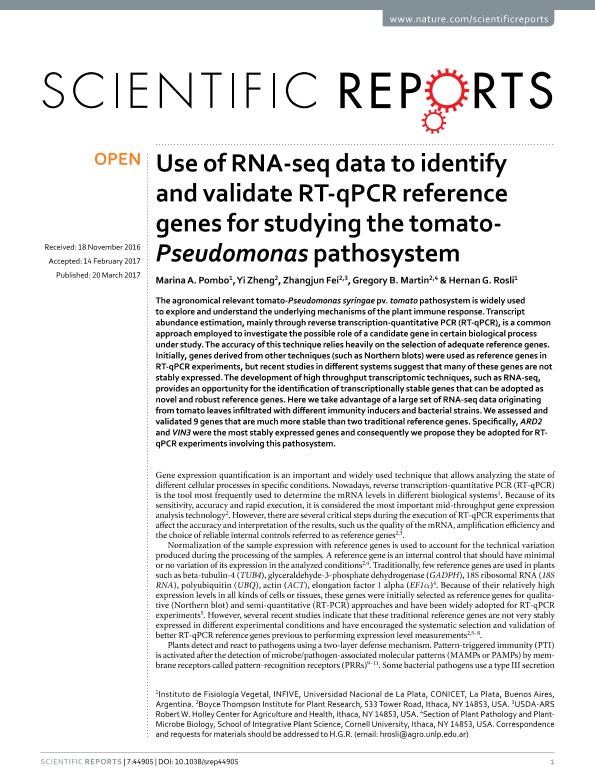Mostrar el registro sencillo del ítem
dc.contributor.author
Pombo, Marina Alejandra

dc.contributor.author
Zheng, Yi
dc.contributor.author
Fei, Zhangjun
dc.contributor.author
Martin, Gregory B.
dc.contributor.author
Rosli, Hernan Guillermo

dc.date.available
2018-11-23T22:07:06Z
dc.date.issued
2017-03
dc.identifier.citation
Pombo, Marina Alejandra; Zheng, Yi; Fei, Zhangjun; Martin, Gregory B.; Rosli, Hernan Guillermo; Use of RNA-seq data to identify and validate RT-qPCR reference genes for studying the tomato-Pseudomonas pathosystem; Nature Publishing Group; Scientific Reports; 7; 3-2017; 1-11; 44905
dc.identifier.issn
2045-2322
dc.identifier.uri
http://hdl.handle.net/11336/65099
dc.description.abstract
The agronomical relevant tomato-Pseudomonas syringae pv. tomato pathosystem is widely used to explore and understand the underlying mechanisms of the plant immune response. Transcript abundance estimation, mainly through reverse transcription-quantitative PCR (RT-qPCR), is a common approach employed to investigate the possible role of a candidate gene in certain biological process under study. The accuracy of this technique relies heavily on the selection of adequate reference genes. Initially, genes derived from other techniques (such as Northern blots) were used as reference genes in RT-qPCR experiments, but recent studies in different systems suggest that many of these genes are not stably expressed. The development of high throughput transcriptomic techniques, such as RNA-seq, provides an opportunity for the identification of transcriptionally stable genes that can be adopted as novel and robust reference genes. Here we take advantage of a large set of RNA-seq data originating from tomato leaves infiltrated with different immunity inducers and bacterial strains. We assessed and validated 9 genes that are much more stable than two traditional reference genes. Specifically, ARD2 and VIN3 were the most stably expressed genes and consequently we propose they be adopted for RT-qPCR experiments involving this pathosystem.
dc.format
application/pdf
dc.language.iso
eng
dc.publisher
Nature Publishing Group

dc.rights
info:eu-repo/semantics/openAccess
dc.rights.uri
https://creativecommons.org/licenses/by-nc-sa/2.5/ar/
dc.subject
Rt-Qpcr
dc.subject
Reference
dc.subject
Rna-Seq
dc.subject
Tomato
dc.subject
Pseudomonas Syringae
dc.subject
Plant Immunity
dc.subject.classification
Otras Ciencias Biológicas

dc.subject.classification
Ciencias Biológicas

dc.subject.classification
CIENCIAS NATURALES Y EXACTAS

dc.title
Use of RNA-seq data to identify and validate RT-qPCR reference genes for studying the tomato-Pseudomonas pathosystem
dc.type
info:eu-repo/semantics/article
dc.type
info:ar-repo/semantics/artículo
dc.type
info:eu-repo/semantics/publishedVersion
dc.date.updated
2018-10-22T22:31:17Z
dc.journal.volume
7
dc.journal.pagination
1-11; 44905
dc.journal.pais
Reino Unido

dc.description.fil
Fil: Pombo, Marina Alejandra. Consejo Nacional de Investigaciones Científicas y Técnicas. Centro Científico Tecnológico Conicet - La Plata. Instituto de Fisiología Vegetal. Universidad Nacional de La Plata. Facultad de Ciencias Naturales y Museo. Instituto de Fisiología Vegetal; Argentina
dc.description.fil
Fil: Zheng, Yi. Boyce Thompson Institute for Plant Research; Estados Unidos
dc.description.fil
Fil: Fei, Zhangjun. Boyce Thompson Institute for Plant Research; Estados Unidos. United States Department of Agriculture; Estados Unidos
dc.description.fil
Fil: Martin, Gregory B.. Boyce Thompson Institute for Plant Research; Estados Unidos. Cornell University; Estados Unidos
dc.description.fil
Fil: Rosli, Hernan Guillermo. Consejo Nacional de Investigaciones Científicas y Técnicas. Centro Científico Tecnológico Conicet - La Plata. Instituto de Fisiología Vegetal. Universidad Nacional de La Plata. Facultad de Ciencias Naturales y Museo. Instituto de Fisiología Vegetal; Argentina
dc.journal.title
Scientific Reports
dc.relation.alternativeid
info:eu-repo/semantics/altIdentifier/doi/http://dx.doi.org/10.1038/srep44905
dc.relation.alternativeid
info:eu-repo/semantics/altIdentifier/url/https://www.nature.com/articles/srep44905
Archivos asociados
